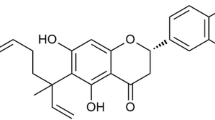Abstract
Phenyl-β-d-glucopyranoside is a component of Phellodendron amurense with anti-cancer and anti-inflammatory activities. In the present study, we investigated the role of phenyl-β-d-glucopyranoside in inflammation using lipopolysaccharide (LPS)-stimulated murine Raw 264.7 macrophages. Phenyl-β-d-glucopyranoside not only inhibited nitric oxide (NO) production but also significantly inhibited the expression of inducible NO synthase (iNOS) and cyclooxygenase-2 (COX-2) without inducing cytotoxicity. Phenyl-β-d-glucopyranoside also attenuated proinflammatory cytokines, including tumor necrosis factor-α (TNF-α), interleukin-1β (IL-1β) and other inflammation-related genes, such as IL-6 in a concentration-dependent manner. Furthermore, phenyl-β-d-glucopyranoside abolished increased adhesion, ninjurin 1 (Ninj1) expression, and matrix metalloproteinase (MMP) activity induced by endotoxin treatment. Finally, phenyl-β-d-glucopyranoside inhibited the nuclear translocation of nuclear factor-κB (NF-κB), which is one of the most important transcription factors involved in the inflammatory process. Taken together, phenyl-β-d-glucopyranoside may be beneficial for the prevention and treatment of anti-inflammatory diseases.







Similar content being viewed by others
References
Lee, H.J., B.J. Ahn, M.W. Shin, J.H. Choi, and K.W. Kim. 2010. Ninjurin1: a potential adhesion molecule and its role in inflammation and tissue remodeling. Molecules and Cells 29: 223–227.
Ferrero-Miliani, L., O.H. Nielsen, P.S. Andersen, and S.E. Girardin. 2007. Chronic inflammation: importance of NOD2 and NALP3 in interleukin-1beta generation. Clinical and Experimental Immunology 147: 227–235.
Lee, H.J., B.J. Ahn, M.W. Shin, J.W. Jeong, J.H. Kim, and K.W. Kim. 2009. Ninjurin1 mediates macrophage-induced programmed cell death during early ocular development. Cell Death and Differentiation 16: 1395–1407.
Schwartz, M., and K. Baruch. 2014. The resolution of neuroinflammation in neurodegeneration: leukocyte recruitment via the choroid plexus. The EMBO Journal 33: 7–22.
Baowen, Q., Z. Yulin, W. Xin, X. Wenjing, Z. Hao, C. Zhizhi, et al. 2010. A further investigation concerning correlation between anti-fibrotic effect of liposomal quercetin and inflammatory cytokines in pulmonary fibrosis. European Journal of Pharmacology 642: 134–139.
Dieterich, L.C., H. Huang, S. Massena, N. Golenhofen, M. Phillipson, and A. Dimberg. 2013. alphaB-crystallin/HspB5 regulates endothelial-leukocyte interactions by enhancing NF-kappaB-induced up-regulation of adhesion molecules ICAM-1, VCAM-1 and E-selectin. Angiogenesis 16: 975–983.
Lee, H.J., and K.W. Kim. 2012. Anti-inflammatory effects of arbutin in lipopolysaccharide-stimulated BV2 microglial cells. Inflammation Research 61: 817–825.
Zhong, X., X. Li, F. Liu, H. Tan, and D. Shang. 2012. Omentin inhibits TNF-alpha-induced expression of adhesion molecules in endothelial cells via ERK/NF-kappaB pathway. Biochemical and Biophysical Research Communications 425: 401–406.
Pan, Y., X. Zhang, Y. Wang, L. Cai, L. Ren, L. Tang, et al. 2013. Targeting JNK by a new curcumin analog to inhibit NF-kB-mediated expression of cell adhesion molecules attenuates renal macrophage infiltration and injury in diabetic mice. PLoS ONE 8: e79084.
Pieper, C.M., A.M. Roza, J.D. Henderson, Y.R. Zhu, and C.S. Lai. 2004. Spatial distribution and temporal onset of NF-kB activation and inducible nitric oxide synthase within pancreatic islets in the pre-diabetic stage of genetic, diabetic-prone BB rats: attenuation by drug intervention decreases inflammatory cell infiltration and incidence of diabetes. Inflammation Research 53: 22–30.
Maruta, H. 2014. Herbal therapeutics that block the oncogenic kinase PAK1: a practical approach towards PAK1-dependent diseases and longevity. Phytotherapy Research 28: 656–672.
Gu, Y., J. Chen, and J. Shen. 2014. Herbal medicines for ischemic stroke: combating inflammation as therapeutic targets. Journal of Neuroimmune Pharmacology 9: 313–339.
Dai, Y., K. Miki, T. Fukuoka, A. Tokunaga, T. Tachibana, E. Kondo, et al. 2000. Suppression of neuropeptides’ mRNA expression by herbal medicines in a rat model of peripheral inflammation. Life Sciences 66: 19–29.
Choi, Y.Y., M.H. Kim, J.M. Han, J. Hong, T.H. Lee, S.H. Kim, et al. 2014. The anti-inflammatory potential of Cortex Phellodendron in vivo and in vitro: down-regulation of NO and iNOS through suppression of NF-kappaB and MAPK activation. International Immunopharmacology 19: 214–220.
Chen, M.L., Y.F. Xian, S.P. Ip, S.H. Tsai, J.Y. Yang, and C.T. Che. 2010. Chemical and biological differentiation of Cortex Phellodendri Chinensis and Cortex Phellodendri Amurensis. Planta Medica 76: 1530–1535.
Xian, Y.F., Q.Q. Mao, S.P. Ip, Z.X. Lin, and C.T. Che. 2011. Comparison on the anti-inflammatory effect of Cortex Phellodendri Chinensis and Cortex Phellodendri Amurensis in 12-O-tetradecanoyl-phorbol-13-acetate-induced ear edema in mice. Journal of Ethnopharmacology 137: 1425–1430.
Mao, Y.F., Y.Q. Li, L. Zong, X.M. You, F.Q. Lin, and L. Jiang. 2010. Methanol extract of Phellodendri cortex alleviates lipopolysaccharide-induced acute airway inflammation in mice. Immunopharmacology and Immunotoxicology 32: 110–115.
Hwang, S.J., Y.W. Kim, Y. Park, H.J. Lee, and K.W. Kim. 2014. Anti-inflammatory effects of chlorogenic acid in lipopolysaccharide-stimulated RAW 264.7 cells. Inflammation Research 63: 81–90.
Zhang, J., P. Wang, H. Ouyang, J. Yin, A. Liu, C. Ma, et al. 2013. Targeting cancer-related inflammation: Chinese herbal medicine inhibits epithelial-to-mesenchymal transition in pancreatic cancer. PLoS ONE 8: e70334.
Kao, S.T., S.D. Wang, J.Y. Wang, C.K. Yu, and H.Y. Lei. 2000. The effect of Chinese herbal medicine, xiao-qing-long tang (XQLT), on allergen-induced bronchial inflammation in mite-sensitized mice. Allergy 55: 1127–1133.
Lee, Y.W., T.L. Chen, Y.R. Shih, C.L. Tsai, C.C. Chang, H.H. Liang, et al. 2014. Adjunctive traditional Chinese medicine therapy improves survival in patients with advanced breast cancer: a population-based study. Cancer 120: 1338–1344.
Park, Y.K., Y.S. Chung, Y.S. Kim, O.Y. Kwon, and T.H. Joh. 2007. Inhibition of gene expression and production of iNOS and TNF-alpha in LPS-stimulated microglia by methanol extract of Phellodendri cortex. International Immunopharmacology 7: 955–962.
Lee, B., B. Sur, I. Shim, H. Lee, and D.H. Hahm. 2012. Phellodendron amurense and its major alkaloid compound, berberine ameliorates scopolamine-induced neuronal impairment and memory dysfunction in rats. The Korean Journal of Physiology & Pharmacology 16: 79–89.
Acknowledgments
This work was supported by the Basic Science Research Program through the National Research Foundation of Korea (NRF) funded by the Korean Government, the Ministry of Science, ICT and Future Planning (2013R1A1A1059709).
Conflict of Interest
The authors declare no conflicts of interest.
Author information
Authors and Affiliations
Corresponding author
Rights and permissions
About this article
Cite this article
Hwang, S.J., Lee, HJ. Phenyl-β-d-Glucopyranoside Exhibits Anti-inflammatory Activity in Lipopolysaccharide-Activated RAW 264.7 Cells. Inflammation 38, 1071–1079 (2015). https://doi.org/10.1007/s10753-014-0072-2
Published:
Issue Date:
DOI: https://doi.org/10.1007/s10753-014-0072-2




